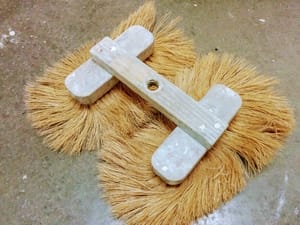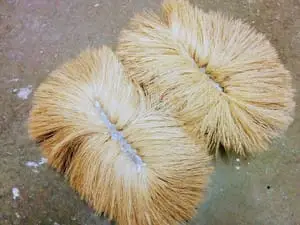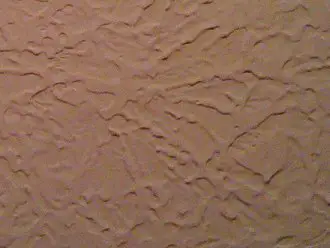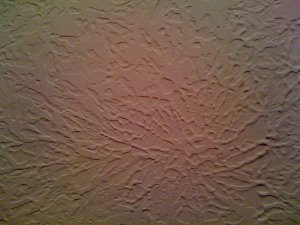
Stomp Knockdown Drywall Texture
Stomp Knockdown Texture is common in new construction across the midwest United States. As the name implies this texture is created by using a brush to stomp patterns in drywall mud across the surface being textured. Once the basic pattern is created a knockdown knife is used to smooth out the high spots. A very similar texture used in the southern part of the U.S. is sometimes referred to as French Lace Texture.
Type of Mud
As with any texture, all-purpose joint compound or topping compound should be used as these types of mud contain more glue-like properties which allow the mud to adhere properly to the drywall surface. The consistency of drywall mud used is the key to creating a good stomp knockdown texture. Water is used to thin the texture mud. The consistency of mud used for stomp knockdown is by far thinner than that used for any other step in drywall finishing.
Texture Mud Viscosity
One way to know whether your texture mud is thin enough is to watch the vortex created by a drywall paddle as it spins mud in a five-gallon bucket. Using an electric spade handle drill spinning at 500rpm/rev, the paddle should create a vortex in the mud that extends three-quarters of the way to the bottom of the bucket. When the mud is too thick, the vortex will not be as deep. If the vortex reaches the bottom of the bucket, the mud is likely too thin.
Applying texture mud for Stomp Knockdown
Drywall mud is first applied to the surface being textured. A common method of application is to use a paint roller with a heavy nap roller to roll the mud evenly across the entire surface. An industrial-strength airless paint sprayer can also be used to apply a thin layer of texture mud. Most professionals prefer a heavy-duty airless sprayer since it is much quicker and easier to control the amount of texture applied.
The amount of mud applied must be consistent across the entire surface. This is critical if you want to create an even uniform Stomp Knockdown Texture.
Stomp a random pattern in the mud
 Once texture mud has been applied to the surface a special brush is used to stomp patterns in the mud. A brush with stiff bristles aligned in an oval pattern across a wooden base works best. The stomp brush should be attached to an extension pole so that you can easily reach the ceiling. These brushes are referred to as crows-foot brushes. Some stomp brushes are made with two heads which makes it easier to move quickly and stomp a maintain a random pattern.
Once texture mud has been applied to the surface a special brush is used to stomp patterns in the mud. A brush with stiff bristles aligned in an oval pattern across a wooden base works best. The stomp brush should be attached to an extension pole so that you can easily reach the ceiling. These brushes are referred to as crows-foot brushes. Some stomp brushes are made with two heads which makes it easier to move quickly and stomp a maintain a random pattern.


Allow to set and knock it down lightly
Finally, once the texture has set slightly, a long flat knife is used to smooth out the surface of the texture. To understand the process, imagine knocking the tips off of stalactites hanging from the ceiling. If done before the drywall mud has sufficient time to set the entire pattern may be smeared, ruining the desired effect. If the mud has set too firmly before it is knocked down, dried pieces of mud are dragged through the surface ruining the underlying pattern. Care must be taken when determining when to start knocking down this texture.
Below are a few more examples of Stomp-Knockdown textures
Back to more texture types
If you have seen Stomp Knockdown texture you are probably also familiar with Rosebud Stomp Ceiling Texture. These two textures are both used extensively in the midwest United States.



